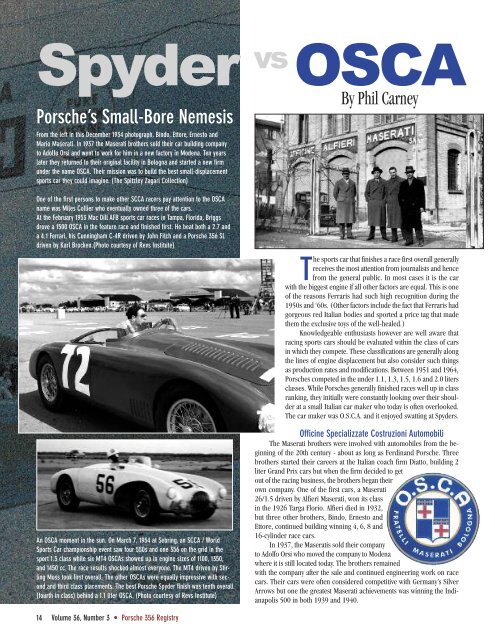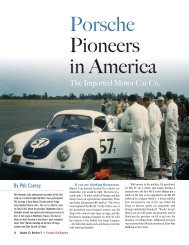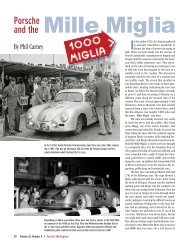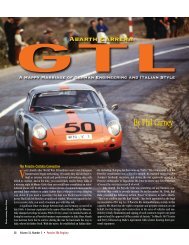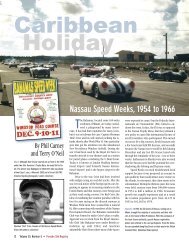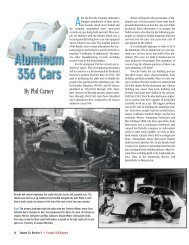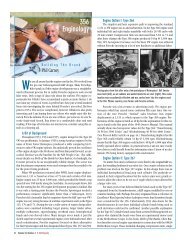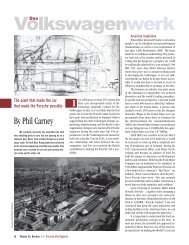You also want an ePaper? Increase the reach of your titles
YUMPU automatically turns print PDFs into web optimized ePapers that Google loves.
<strong>Spyder</strong> <strong>vs</strong> <strong>OSCA</strong><br />
Porsche’s Small-Bore Nemesis<br />
From the left in this December 1934 photograph, Bindo, Ettore, Ernesto and<br />
Mario Maserati. In 1937 the Maserati brothers sold their car building company<br />
to Adolfo Orsi and went to work for him in a new factory in Modena. Ten years<br />
later they returned to their original facility in Bologna and started a new firm<br />
under the name <strong>OSCA</strong>. Their mission was to build the best small-displacement<br />
sports car they could imagine. (The Spitzley Zagari Collection)<br />
By Phil Carney<br />
One of the first persons to make other SCCA racers pay attention to the <strong>OSCA</strong><br />
name was Miles Collier who eventually owned three of the cars.<br />
At the February 1953 Mac Dill AFB sports car races in Tampa, Florida, Briggs<br />
drove a 1500 <strong>OSCA</strong> in the feature race and finished first. He beat both a 2.7 and<br />
a 4.1 Ferrari, his Cunningham C-4R driven by John Fitch and a Porsche 356 SL<br />
driven by Karl Brocken.(Photo courtesy of Re<strong>vs</strong> Institute)<br />
An <strong>OSCA</strong> moment in the sun. On March 7, 1954 at Sebring, an SCCA / World<br />
Sports Car championship event saw four 550s and one 356 on the grid in the<br />
sport 1.5 class while six MT4 <strong>OSCA</strong>s showed up in engine sizes of 1100, 1350,<br />
and 1450 cc. The race results shocked almost everyone. The MT4 driven by Stirling<br />
Moss took first overall. The other <strong>OSCA</strong>s were equally impressive with second<br />
and third class placements. The best Porsche <strong>Spyder</strong> finish was tenth overall<br />
(fourth in class) behind a 1.1 liter <strong>OSCA</strong>. (Photo courtesy of Re<strong>vs</strong> Institute)<br />
The sports car that finishes a race first overall generally<br />
receives the most attention from journalists and hence<br />
from the general public. In most cases it is the car<br />
with the biggest engine if all other factors are equal. This is one<br />
of the reasons Ferraris had such high recognition during the<br />
1950s and ‘60s. (Other factors include the fact that Ferraris had<br />
gorgeo<strong>us</strong> red Italian bodies and sported a price tag that made<br />
them the excl<strong>us</strong>ive toys of the well-healed.)<br />
Knowledgeable enth<strong>us</strong>iasts however are well aware that<br />
racing sports cars should be evaluated within the class of cars<br />
in which they compete. These classifications are generally along<br />
the lines of engine displacement but also consider such things<br />
as production rates and modifications. Between 1951 and 1964,<br />
Porsches competed in the under 1.1, 1.3, 1.5, 1.6 and 2.0 liters<br />
classes. While Porsches generally finished races well up in class<br />
ranking, they initially were constantly looking over their shoulder<br />
at a small Italian car maker who today is often overlooked.<br />
The car maker was O.S.C.A. and it enjoyed swatting at <strong>Spyder</strong>s.<br />
Officine Specializzate Costruzioni Automobili<br />
The Maserati brothers were involved with automobiles from the beginning<br />
of the 20th century - about as long as Ferdinand Porsche. Three<br />
brothers started their careers at the Italian coach firm Diatto, building 2<br />
liter Grand Prix cars but when the firm decided to get<br />
out of the racing b<strong>us</strong>iness, the brothers began their<br />
own company. One of the first cars, a Maserati<br />
26/1.5 driven by Alfieri Maserati, won its class<br />
in the 1926 Targa Florio. Alfieri died in 1932,<br />
but three other brothers, Bindo, Ernesto and<br />
Ettore, continued building winning 4, 6, 8 and<br />
16-cylinder race cars.<br />
In 1937, the Maseratis sold their company<br />
to Adolfo Orsi who moved the company to Modena<br />
where it is still located today. The brothers remained<br />
with the company after the sale and continued engineering work on race<br />
cars. Their cars were often considered competitive with Germany’s Silver<br />
Arrows but one the greatest Maserati achievements was winning the Indianapolis<br />
500 in both 1939 and 1940.<br />
14 Volume 36, Number 3 • Porsche 356 Registry
After their ten-year contract with Orsi elapsed in 1947, Ernesto, Ettore<br />
and Bindo Maserati formed their own firm. The new company was officially<br />
registered as Officine Specializzate Costruzioni Automobili - Fratelli Maserati<br />
SpA (Maserati Brothers’ Specialized Workshop for Car Construction) but<br />
is most often known by the nicknames O.S.C.A., <strong>OSCA</strong> or Osca. They located<br />
in San Lazzaro di Saveno j<strong>us</strong>t outside Bologna in an abandoned portion of<br />
the original Maserati factory. Together with nine employees, the brothers<br />
began construction of 1.1-liter sports racing cars; a category in which they<br />
were very capable.<br />
The first model, the MT4 (which stood for Maserati Tipo 4) had a<br />
cycle-fender, roadster body. The power plant was based on Fiat hardware,<br />
displacement was 1,092 cc and 72 hp was produced at 6,000 rpm. <strong>OSCA</strong><br />
raced three times in 1948 with two DNFs followed by a first overall at the I<br />
Gran Premio di Napoli (first Grand Prix of Naples). Not a bad start for three<br />
highly skilled brothers with only a handful of employees.<br />
In 1950 a new version of the MT4 began making a big impression in<br />
sports car racing. The engine had been updated to dual cams and the wheels<br />
were now enclosed. A class win was taken at the Mille Miglia that year followed<br />
by a 1-2 finish at Monza. By the end of the ’51 season <strong>OSCA</strong> had 21<br />
wins in 39 starts.<br />
Other models followed beca<strong>us</strong>e the Maserati brothers always strived<br />
to build the most competitive, small-displacement race car. This resulted<br />
in a near bewildering set of car designations all produced in very low volume.<br />
Before going out of b<strong>us</strong>iness in the late 1960s, approximately only<br />
257 cars had been built. Although total <strong>OSCA</strong> output was a small fraction of<br />
Porsche production during the same period the diminutive Italian cars<br />
nipped at Porsche’s heels when they both appeared in the same race.<br />
World Sport Car Championship<br />
Race fans beamed with pride when journalists debated<br />
who the “best” man on the track was and then a<br />
driver from their country won the race. So the International<br />
Sporting Commission (C.S.I.) of the Federation<br />
de l’Automobile (F.I.A.) started a Driver’s Championship<br />
series in 1950. Similarly a European Touring Championship<br />
for rallies was begun in 1953. And at the Monte<br />
Carlo Congress in February of 1953, the C.S.I. also initiated<br />
the World Sports Car Championship (WSC) to<br />
recognize manufacturer achievements. The first WSC<br />
competition was the 1953 Sebring 12 Hours race held<br />
j<strong>us</strong>t a few months after the C.S.I announced the series.<br />
The WSC is generally broken up into five periods<br />
From top: • The first MT4s had cycle-fenders and were known as siluros or “torpedoes”.<br />
This style was soon replaced by bodies having attached fenders. Chassis 1112<br />
was the second MT4 2AD built. In 1951, Luigi Fagioli drove the car to a class victory at<br />
the Mille Miglia. Recently restored, it is regularly vintage raced. (conceptcarz.com)<br />
• The most curvaceo<strong>us</strong> style and the one more commonly seen today is the barchetta<br />
or “little boat" which came out in 1952. This is a nice close up of Al Coppel’s 1,098-cc<br />
<strong>OSCA</strong> at the 1954 Pebble Beach race. At that time, the MT4 was the sports car to be<br />
racing in class F or G. (Julian Graham photo, courtesy Robert Devlin)<br />
• 1953, change on the horizon. After the war, MGs were the most common car to be<br />
seen at racing events but the first <strong>OSCA</strong>s were also showing up in America. Here<br />
Henry Wessells in the #60 <strong>OSCA</strong> has finished passing Bob Holbert’s #14 MG TD. Wessells<br />
took second behind George Moffett’s <strong>OSCA</strong> . (Alix Lafontant © Carl Goodwin)<br />
• This wonderful shot was taken at the soaked Pebble Beach Cup race in the spring<br />
of 1955 although the order of the cars is not indicative of the final results. Chick Lesson<br />
piloting <strong>OSCA</strong> #117 was second in the FM class beaten by Ken Miles in an MG<br />
Special. The other cars in this photo are the #23 <strong>OSCA</strong> raced by Al Coppel (5th in FM)<br />
and #25 MG R-1 driven by Cy Yedor (3rd in class).<br />
(Photo by William C. Brooks, courtesy of Robert Devlin)<br />
www.Porsche356Registry.org • September / October 2012 15
and for the purposes of this article about Porsche and <strong>OSCA</strong> only the first<br />
period is significant to the story. Only sports cars with large engines captured<br />
the WSC title during this time frame with Ferrari holding the title<br />
seven times in the first nine years. That was beca<strong>us</strong>e the point system was<br />
biased towards overall winners instead of class winners. Some race organizers<br />
recognized this skew and awarded additional recognition aimed at<br />
leveling the notoriety. For example, both Le Mans and Sebring bestowed<br />
an “Index of Performance” reward to the car that achieved the highest actual<br />
mileage compared to a preset distance that was a function of engine<br />
size. While such an award may make sense to the technical community, it<br />
never really caught on with the general public.<br />
The first <strong>OSCA</strong>s were brought into the U.S. privately in 1952. The Momo Corporation<br />
and Luigi Chinetti started importing them officially soon afterwards. In<br />
the western U.S., Edgar Fronteras became America’s distributor/dealer with<br />
b<strong>us</strong>iness associates Bumpy Bell and Chapman at ALMAR Motors in Tucson.<br />
Two videos from the 1954 Sebring<br />
12 Hour Race can be seen on<br />
YouTube. They’re grainy<br />
and short but give a marvelo<strong>us</strong><br />
feel for the scary simplicity of racing<br />
in that era. Search “Sebring 12<br />
hour 1954” at YouTube.<br />
Vid<br />
Hit<br />
Whoops, a little spin by Rees Makins driving one of his MT4s at Watkins Glen in<br />
1954. This car was equipped with a 1,092 cc engine and ran in G MOD. The deviation<br />
cost Makins dearly and he crossed the finish line behind two Siatas. (Alix<br />
Lafontant © Carl Goodwin)<br />
First Match Up<br />
The Argentine Grand Prix was first held in 1953 and was sufficiently<br />
successful that the C.S.I. decided it would open its 1954 WSC season with<br />
a 1000 Km (621.4 miles) race in Buenos Aires. It was the first opportunity<br />
for <strong>OSCA</strong> and Porsche to battle head-to-head in the series. There were a<br />
total of six Type 550s entered and four were equipped with new four-cam<br />
engines. Two MT4 <strong>OSCA</strong>s were on the starting grid but one was powered<br />
by an 1,100-cc engine while the other ho<strong>us</strong>ed a 1,350 cc power plant. All<br />
of the cars, Porsches and <strong>OSCA</strong>s, were classified in the under-1.5 liter sports<br />
category. It is unsurprising that Porsche took the class win with a <strong>Spyder</strong><br />
entered by Jaroslav Juhan – a part-time factory driver and the man instrumental<br />
in making the Porsche brand known in South American. The spoiler<br />
in the pudding was that the 1.1-liter <strong>OSCA</strong> took 2nd place in the same class<br />
with four other <strong>Spyder</strong>s trailing in the 3 though 6 positions. Should Porsche<br />
have taken this as an omen? Definitely.<br />
The next WSC race was j<strong>us</strong>t six weeks later in Sebring, Florida. Both<br />
marques were out in force and the combatants could not have been more<br />
evenly matched. Four 550s and one 356 were on the grid in the sport 1.5<br />
class while six MT4 <strong>OSCA</strong>s showed up in engine sizes of 1100, 1350, and<br />
1450 cc. The race results shocked almost everyone. Not only did Briggs<br />
Cunningham’s MT4 driven by Stirling Moss win its class, it also took first<br />
place overall. Briggs was subtly proud simply stating, “It pleased all of <strong>us</strong><br />
to win over so many larger cars at Sebring.” Other <strong>OSCA</strong> results were<br />
equally impressive with second and third S1.5 class placements. For <strong>OSCA</strong>,<br />
the icing on the cake was that their group took the top four spots in the<br />
Index of Performance. The best Porsche <strong>Spyder</strong> accomplishment was tenth<br />
overall (fourth in class) behind a 1.1 liter <strong>OSCA</strong>. Road & Track in their review<br />
declared “the <strong>OSCA</strong>s stole the entire show.”<br />
The next matchup was the Mille Miglia. As described in the past March<br />
issue, the team of Herrmann and Linge campaigned their 550 spectacularly<br />
taking the S1.5 class win. Twenty minutes behind them was an MT4 that<br />
had been driven single handedly the entire 1,000 miles by Giulio Cabianca.<br />
The Le Mans race a month later should have been very telling. The Porsche<br />
factory entered three <strong>Spyder</strong>s and the Maserati brothers entered two MT4s<br />
in the same class. Although two <strong>Spyder</strong>s dropped out with engine problems,<br />
Porsche took the class win. As for the <strong>OSCA</strong>s, one of their cars was DNF<br />
due to an accident while the second was disqualified for receiving outside<br />
assistance. Statistically it was still difficult to figure out the better car. The<br />
last WSC 1954 race was the Carrera Panamerica. Six Porsches were entered<br />
in the Sport 1500 class; four 550s and two 356s. Three MT4s were in the<br />
same class. The Mexican race results seemed to provide a clearer picture<br />
of the Porsche-<strong>OSCA</strong> competition. <strong>Spyder</strong>s finished in class 1-2-4-5. One<br />
<strong>OSCA</strong> occupied the third position while the other two were DNF. The year<br />
1954 might be considered a draw between the two rivals. Perhaps 1955<br />
would provide a more definitive answer as to the best racer in the 1.5 liter<br />
Sports Car class.<br />
Left: There were a lot of <strong>OSCA</strong>s and Porsches at Watkins Glen in the fall of 1954.<br />
Frank Bott takes the checkered flag driving one of a Rees Makins’ MT4 1500 in the<br />
Queen Catherine Cup race. (Alix Lafontant photo, Carl Goodwin collection).<br />
16 Volume 36, Number 3 • Porsche 356 Registry
During 1954 the most common race tracks were SAC Air Force bases made temporarily<br />
available while the bombers were off on a “training” flight. At Lockbourne<br />
AFB, Rees Makins is being congratulated by Col. T. K. Field who was<br />
serving as a race official. Based on the car’s distinct fenders, it is obvio<strong>us</strong> that<br />
Makins owned one of the very earliest <strong>OSCA</strong>s made.<br />
(Alix Lafontant © Carl Goodwin)<br />
At Watkins Glen in 1955 Briggs Cunningham was leading at the beginning of the<br />
race but fell victim to a broken axle on lap nine. The Porsche <strong>Spyder</strong>s of Art<br />
Bunker and Fred Procter finished second and fourth. The winner was a Siata<br />
Special driven by Bill Weldon. Lot<strong>us</strong> was also giving Porsche some competition<br />
at the time. A Mk IX was running in G MOD during the race and it managed a finish<br />
between the two 550s. (Alix Lafontant © Carl Goodwin)<br />
And Rematch<br />
In the six World Sports Car races during 1955, Porsche<br />
and <strong>OSCA</strong> went head-to-head in three events. The first rematch<br />
was at Sebring in March with the contestant scale balanced;<br />
six <strong>Spyder</strong>s vers<strong>us</strong> six MT4s. Remembering the<br />
previo<strong>us</strong> year results at Sebring, Jeff Cooper of Road &<br />
Track had this advice for Porsche, “An <strong>OSCA</strong> will get you if<br />
you don’t watch out.” The S1.5 class favorites were Cunningham’s<br />
<strong>OSCA</strong> against the Porsche work’s 550 driven by<br />
Herbert Linge. What might seem curio<strong>us</strong> is that Briggs Cunningham<br />
was a co-sponsor of the factory <strong>Spyder</strong> meaning<br />
he was sort of competing against himself. However, in context<br />
it made perfect sense beca<strong>us</strong>e Briggs loved racing and<br />
he loved race cars of all breeds. For the 1955 Sebring he<br />
also brought along a D-Type Jag and his own Offy-powered<br />
C6R.<br />
There was quite a bit of controversy about the race.<br />
First, the F.I.A. had defined a production model as one with<br />
25 examples having been built. The <strong>OSCA</strong> was therefore considered<br />
a production car (as was the 356) but the Type 550<br />
would not arrive at that sales figure until later in the year.<br />
The beginning of the race was also a mess when six reserve<br />
entries took off during the Le Mans type start along with the<br />
eligible cars. Before the offenders could be flagged off the<br />
track, an unauthorized Renault crashed and ca<strong>us</strong>ed a favored Ferrari to<br />
also crash taking it out of the game. Too make matters worse, the race<br />
ended with even more conf<strong>us</strong>ion. The two leading cars were a 3.5-liter<br />
Jaguar D-Type driven by Mike Hawthorne and Phil Walters up against a 3.0-<br />
liter Ferrari 750S Monza driven by Phil Hill and Carroll Shelby. For 12<br />
hours the two cars were never separated by more than seven minutes. The<br />
Ferrari was flagged the winner but the Jag team was called to the victory<br />
stand. It was a full week later before Cunningham’s Jag was officially recognized<br />
as the overall winner at Sebring.<br />
But what about the S1.5 class (or the “F” class as Americans referred<br />
to it). As in the previo<strong>us</strong> year, Cunningham’s MT4, this time driven by Bill<br />
Lloyd and George Huntoon, took home the honors. The Porsche/Cunningham<br />
550 driven by H<strong>us</strong>chke von Hanstein was second. Another <strong>OSCA</strong><br />
placed third and another Porsche took fourth in class. As for the often overlooked<br />
Sebring Index of Performance award, Ferrari was number one,<br />
<strong>OSCA</strong> second, Jaguar third, a 2.7 liter A<strong>us</strong>tin-Healey fourth and Porsche<br />
fifth.<br />
The next WSC encounter between Porsche and <strong>OSCA</strong> was two months<br />
later at Brescia in the May Mille Miglia where Porsche had achieved a narrow<br />
victory the previo<strong>us</strong> year. For 1955 in S1.5 there were four 550s, three<br />
MT4 1500s, three Siatas, two Alfa Romeos and one each Peugeot, Gordini,<br />
and Ermini. Again Porsche came out victorio<strong>us</strong> (first in class, eighth overall)<br />
with the <strong>OSCA</strong> 21 minutes behind (second in class and 14th overall).<br />
Although there were no Porsches entered in the S1.1 class, it is worth giving<br />
<strong>OSCA</strong> honorable mention, for it won in this class against 13 competitors of<br />
eight different marques. The 1955 score was now tied.<br />
The competition fulcrum, as the reader might s<strong>us</strong>pect, would be Le<br />
Mans in June. There were four 1.5 liter 550s up against a single <strong>OSCA</strong>. In<br />
the 1.1 class there were another two <strong>Spyder</strong>s but surprisingly no MT4s<br />
competed in this category. The Porsche <strong>Spyder</strong>s took spots one through<br />
three at Le Mans in 1955 with the sole MT4 entered by America Edgar Fronteras<br />
in fourth.<br />
After Le Mans there were two more WCS races. In September Porsches<br />
won their class in the Dundrod Tourist Trophy but no <strong>OSCA</strong>s challenged<br />
them. Similarly, at the Targa Florio in October, <strong>OSCA</strong>s won the S1.1 and<br />
S1.5 class but Porsche was a no-show.<br />
18 Volume 36, Number 3 • Porsche 356 Registry
The Debate Continues<br />
The horrific and highly-publicized<br />
tragedy at Le Mans in 1955 had a number of<br />
ripple effects. Although figuring prominently<br />
in the Le Mans tragedy, Mercedes-Benz won<br />
the WSC championship in 1955. Despite capturing<br />
the title, after the season closed the<br />
company announced it was withdrawing from<br />
both Grand Prix and sports car racing. Another<br />
surprise was that the Automobile Club<br />
de l’Quest, the organization that officiated at<br />
Le Mans, announced several rule changes for<br />
1956 and one of these restricted prototypes<br />
to 2½ liters. This conflicted with WSC rules<br />
which ca<strong>us</strong>ed the F.I.A. to exclude Le Mans<br />
from the manufacturer’s title series that year.<br />
In 1956 there were six WSC events<br />
scheduled but the final one, the Carrera<br />
Panamericana race, never materialized.<br />
Porsche and <strong>OSCA</strong> directly confronted each<br />
other in only two events, the Mille Miglia and<br />
at the Nürburgring. In Italy’s 23rd Mille,<br />
Porsche’s appearance was dismal. Four <strong>Spyder</strong>s<br />
ran in the Sports 1500 class and three<br />
retired. The surviving 550 driven by Rolf Knoch finished fourth in class its<br />
arrival was bettered by an <strong>OSCA</strong> MT4 and two Maserati 150Ss. An 1100<br />
<strong>OSCA</strong> MT4 also took its class win. The German Nürburgring proved more<br />
fertile ground for Porsche beca<strong>us</strong>e there <strong>Spyder</strong>s came in first and second<br />
and the lone MT4 experienced engine failure.<br />
Seven WSC competitions were held in<br />
1957. The Sveriges Grand Prix in Kristianstad,<br />
Sweden had been added the year<br />
earlier and, to extend the season, the Grand<br />
Prix of Venezuela was added in November.<br />
<strong>OSCA</strong> began the series on top with a class<br />
win in Buenos Aires but for the rest of the<br />
year there were <strong>Spyder</strong>s in the victory circle.<br />
At Caracas Porsche introduced their new 718<br />
RSK and it made life for the Maseratti brothers<br />
even more difficult.<br />
During 1958 Porsche <strong>Spyder</strong>s won<br />
every WSC encounter against <strong>OSCA</strong>s. Looking<br />
at the detailed results makes one wonder if<br />
Ernesto, Ettore and Bindo had lost foc<strong>us</strong> as<br />
they added several new, small-displacement<br />
variants including the F2, S750, S750 TN,<br />
S1500 and 1500 TN. <strong>OSCA</strong> was still a very<br />
small firm and to explore so many design alternatives<br />
seems diluting in retrospect. Admittedly, <strong>OSCA</strong>s were still<br />
Porsche’s best competition in class but they were now consistently playing<br />
a disappointing second fiddle in every encounter. The years 1959 through<br />
1961 proved no better for <strong>OSCA</strong> in WSC races.<br />
Competition Among Amateurs<br />
When there was a world championship title at stake, manufacturers<br />
wanted to provide the best opportunity for success. Therefore Porsche,<br />
<strong>OSCA</strong>, Ferrari, and many other builders entered cars the factory had specifically<br />
prepared for each specific race. For vario<strong>us</strong> reasons, it was also not<br />
uncommon for a car company to authorize private teams to represent the<br />
builder but in these situations, the private party received excellent factory<br />
support. Continued<br />
When car racing got into full swing after the war, some wealthy owners ran<br />
cars from different marques so that they were especially competitive in different<br />
classes. This is a picture of two cars in Jim Kimberly’s stable. Up front is<br />
his <strong>OSCA</strong> 1500 and partially seen behind it is his 4.5 liter Ferrari.<br />
(Alix Lafontant © Carl Goodwin)<br />
Although they were fierce competitors during the mid 1950s, it is difficult to<br />
find a frame in which an <strong>OSCA</strong> and a Porsche are battling mano a mano. This<br />
Ron Ferreira photo was taken at Fifth Annual Stockton Lions Club Sports Car<br />
Races in March 1957 when <strong>OSCA</strong>’s glory was fading under a Porsche onslaught.<br />
<strong>Spyder</strong> #12 is being driven by Ed Beagle who finished 3rd. <strong>OSCA</strong> #10 was a 750<br />
cc S-187 model piloted by Willliam Bell who was not part of the podium. This<br />
model and a few other <strong>OSCA</strong>s were not <strong>us</strong>ually contending directly with<br />
Porsche <strong>Spyder</strong>s or 356s. (Courtesy Robert Devlin)<br />
www.Porsche356Registry.org • September / October 2012 19
So what about battles between drivers without<br />
direct factory support? It is a bit difficult to draw<br />
real objective comparisons in many of these situations<br />
beca<strong>us</strong>e some owner/racers had a distinct advantage<br />
over others. In the 1950s the sport evolved<br />
from gentleman drivers to professionals who expected<br />
to be paid for their skill and services. Some<br />
owners were very wealthy and could therefore afford<br />
the best drivers supported by a highly skilled<br />
group of mechanics. The majority of “amateurs”<br />
did not have bundles of money to spend on racing.<br />
Despite these caveats, it is nevertheless interesting<br />
to compare Porsche and <strong>OSCA</strong> results in American’s<br />
SCCA battles.<br />
In the 1956 Mille Miglia, Hans Herrmann (right) was teamed up with Werner<br />
Enz left) but Hermann’s fortunes that year were not quite as good as in the<br />
past. Giulio Cabianca in his <strong>OSCA</strong> MT4 1500 produced a first in S1.5 class and<br />
9th overall. (Courtesy Porsche archive)<br />
At the 1957 Italian Mille, Umberto Maglioli did a repeat performance of his<br />
previo<strong>us</strong> year’s accomplishments in Italy’s Targa Florio. He produced a first in<br />
class and a 5th overall. There were over a dozen <strong>OSCA</strong>s in the race. In the S1.1<br />
and S750 classes they dominated but were DNF up against the Porsche <strong>Spyder</strong>s.<br />
(Courtesy Porsche archive)<br />
SCCA Competition<br />
If you look into early 1950s SCCA results you<br />
will notice that there were many makes of cars on<br />
the track. It was not a foregone concl<strong>us</strong>ion that<br />
Porsche would become a dominate player on and<br />
off the track. In fact, looking only at race entries,<br />
one might guess that MG was the manufacturer that<br />
would lead sports car racing enth<strong>us</strong>iasts into the<br />
next decade. Such a concl<strong>us</strong>ion was correct in terms of sales with almost<br />
400,000 MGBs sold in the United States through the late ‘70s. MG, however,<br />
would not be the competitor to be feared on the track.<br />
The first <strong>OSCA</strong> vers<strong>us</strong> Porsche battle occurred at Bridgehampton in<br />
May of 1952. Rees Makins brought a 1.1-liter, cycle-fendered MT4 roadster<br />
that he had j<strong>us</strong>t imported to the race. Porsche was represented by two of<br />
its finest race 1.5 liter cars, a 356 SL owned by Ed Trego and Glöckler-<br />
Porsche #2 owned by Max Hoffman. Max took an early lead but had an unhappy<br />
incident with some hay bales that slowed him down. This allowed<br />
the <strong>OSCA</strong> driven by Frank Bott to win the Mecox Trophy Race. The 356 SL<br />
was driven by Karl Brocken and it failed to finish after an off-course contact.<br />
That race put <strong>OSCA</strong> on the scoreboard first and although driver skill played<br />
a part in the race, <strong>OSCA</strong>s were not going to be easily defeated by Porsche<br />
for several years.<br />
MT4s clearly dominated their classes in SCCA races through 1954.<br />
The man that led the charge was Briggs Cunningham who owned both a<br />
1,092 and a 1,342-cc car. This was the last year that Air Force Bases would<br />
be made available for SCCA racing and there was plenty of action on those<br />
runways. The first race to show the merits of the <strong>OSCA</strong> was the Florida National<br />
Sports car Races held at MacDill AFB on January 31st. In the F-Modified<br />
(FM) class there were three <strong>OSCA</strong>s up against an equal number of<br />
Porsches. In this 50 mile race the MT4s finished in the top three spots with<br />
Ed Crawford and Gordon Lipe’s <strong>Spyder</strong>s in the number 4 and 5 slots. Cunningham<br />
was a good driver and finished in third place that day. However,<br />
as is described above, when his <strong>OSCA</strong> was put in the hands of an exceptional<br />
driver like Stirling Moss, the results were quite astounding as seen at the<br />
SCCA/WSC Sebring race of 1954.<br />
An uncommon matchup (beca<strong>us</strong>e it was on the West Coast) occurred<br />
at Pebble Beach in April. John von Neumann was driving 550-03 and was<br />
plagued by brake fade on the twisty course and had to be satisfied with a<br />
second place finish behind Chick Leson’s <strong>OSCA</strong>. Later that year, von Neumann<br />
sold his <strong>Spyder</strong> to Sherwood Johnston where it competed against an<br />
<strong>OSCA</strong> at Thompson, Connecticut and the results were the same.<br />
The National Capital Sports Car Races at Andrews AFB should have<br />
been a great opportunity for comparing cars. There were lots of <strong>OSCA</strong>s and<br />
lots of Porsches but the marques raced in the different F-Modified and F-<br />
Production classes. Still a couple of anecdotes are applicable. In the second<br />
Continued on page 22<br />
20 Volume 36, Number 3 • Porsche 356 Registry
ace, Rees Makins’ 1.1-liter MT4 bettered all of the 1.5 liter 356s. In the<br />
final featured race of 200 miles, the 1.5 MT4s of Briggs Cunningham and<br />
Sherwood Johnston (the same guy who would later buy 550-03 from von<br />
Neumann) finished third and sixth overall. Considering that their competition<br />
was three, four and five liter Ferraris, Jaguars and Aston Martins, the<br />
<strong>OSCA</strong>s put on quite a demonstration.<br />
It would be possible to identify many more instances where <strong>OSCA</strong>s<br />
dominated the SCCA events of 1954 including Offutt AFB, Lockbourne AFB,<br />
and March AFB. The bottom line can be clearly shown by looking at the<br />
SCCA FM class standings at the end of the year: Cunningham/<strong>OSCA</strong> 4375<br />
pts, Stewart/<strong>OSCA</strong> 2750 pts, David/<strong>OSCA</strong> 2500 pts, Black/Lester MG 2375<br />
pts, Moffet/<strong>OSCA</strong> 2250 pts, von Neumann/Porsche 2250 pts, Simpson/<strong>OSCA</strong><br />
2250 pts, Crawford/Porsche 1875 pts. Of course there were not many fourcam<br />
<strong>Spyder</strong>s in the States at that time so 1955 results might be more insightful.<br />
<strong>OSCA</strong>s Against Four-Cams<br />
The 1955 SCCA season started with the WSC Sebring race (described<br />
above) and <strong>OSCA</strong> was out in front. <strong>OSCA</strong>s and Porsches were entered in<br />
the April Pebble Beach races; however it is difficult to draw comparisons<br />
since each brand performed admirably in different classes. In the May Cumberland<br />
second race, Norm Christiansen’s 550 bettered J.R. Johnston’s<br />
<strong>OSCA</strong> but later on in the tenth race, Phil Stewart’s <strong>OSCA</strong> shut down the <strong>Spyder</strong>s<br />
campaigned by noted drivers Herbert Linge, Ed Crawford, Fred Procter<br />
and Evans Hunt.<br />
At Bakersfield in May there was a bit of conf<strong>us</strong>ion with the rules and<br />
SCCA bookkeeping (which was not that uncommon during this period).<br />
Skip Swartley’s <strong>OSCA</strong> was considered as FM but Don Brittson’s <strong>Spyder</strong> was<br />
considered F-Production (go figure). Well Swartley finished 4th overall but<br />
that was not the big surprise. James Dean in his Speedster (truly F-Production)<br />
took the win over Brittson’s <strong>Spyder</strong> which was racing in the same<br />
class.<br />
In SCCA racing, things began to get brighter for Porsche at Iowa City.<br />
The fourth race was defined as “Sports & Production Sports” and included<br />
both 550s and an MT4. That weekend the <strong>Spyder</strong>s of Davis and Crawford<br />
took 1-2 while the MT4 of Phil Stewart cleaned up in 3rd. At the June<br />
Lawrenceville, Illinois, Sports Car Races, the <strong>Spyder</strong>s of Ed Crawford and<br />
Art Bunker bettered the <strong>OSCA</strong>s of James Johnston and Phil Stewart. A week<br />
later in Milwaukee Frank Botts’ Osca bettered Bob Ballinger’s <strong>Spyder</strong>. During<br />
the first week of September Walt Hansgen in a <strong>Spyder</strong> beat the pants off<br />
Cunningham in an <strong>OSCA</strong> at Thompson. A week later at Elkhart Lake, Bott<br />
and Cunnigham’s MT4s bettered Crawford and Davis’ <strong>Spyder</strong>s.<br />
So it went for the rest of the season. A Porsche was in the winner’s<br />
circle in one race and an <strong>OSCA</strong> in another. When the SCCA tallied up the<br />
scores in January, John von Neumann and his 550 was on top scoring 4,250<br />
points. Briggs Cunningham racked up 3,750 points which was composed<br />
of 750 points driving his <strong>Spyder</strong> and another 3,000 points behind the wheel<br />
of his <strong>OSCA</strong>.<br />
A couple of preliminary concl<strong>us</strong>ions can be drawn after looking at<br />
SCCA race results that year. First, it was certain that having a four-cam instead<br />
of a p<strong>us</strong>h rod in a <strong>Spyder</strong> was a vast improvement. Second there were<br />
many more Porsche <strong>Spyder</strong>s being built and sold in the United States than<br />
<strong>OSCA</strong> MT4s. If 1955 SCCA results in FM are analytically examined today, it<br />
seems as clear as mud whether one should bargain with Max Hoffman in<br />
New York to get a 550 or Edgar Fronteras in Chicago to buy an MT4. Sports<br />
car enth<strong>us</strong>iasts of the time however apparently had a more lucid vision.<br />
The Winner Emerges<br />
SCCA results show that as the year 1956 progressed, fewer <strong>OSCA</strong>s were<br />
being entered in races and none were able to overcome <strong>Spyder</strong>s in competition.<br />
Speaking with those who were involved with the sport during that<br />
time frame, there appear to be multiple reasons for <strong>OSCA</strong>s fading into the<br />
background. First, the earliest <strong>Spyder</strong>s were delivered with 1500 Supers<br />
engines and a gear set that put them at a disadvantage on shorter course.<br />
For example at Sebring, the longest straight was insufficient for <strong>Spyder</strong>s to<br />
peak in top gear. As development progressed, Porsche made other ratios<br />
available that gave the better acceleration so necessary on twisty courses.<br />
Another factor at play was sales. The Maserati brothers made very few<br />
cars and there was always a long waiting list. No matter how well their cars<br />
sold, the brothers were not to be r<strong>us</strong>hed into any process other than methodically<br />
hand-building cars one at a time. Porsche on the other hand was<br />
building 356s on a volume basis and, as a result, knew how to apply more<br />
efficient production methods to race car building as well. In additional to<br />
producing a greater number of <strong>Spyder</strong>s, Porsche was capable of selling<br />
them over 30% cheaper than the Maserati brothers could price their MT4s.<br />
The website www.RacingSportsCars.com provides some interesting<br />
statistics. Including all models, <strong>OSCA</strong>s were involved in some 838 races<br />
around the world between 1948 and 1970. MT4s were the most popular<br />
model representing about 50% of the entries. <strong>OSCA</strong>s managed 165 overall<br />
wins and an additional 187 class wins during their careers and as you likely<br />
s<strong>us</strong>pect, the majority of this activity was in Italy in the hands of Italian pilots<br />
although U. S. activity is a close second.<br />
Differing B<strong>us</strong>iness Plans<br />
In the mid-twentieth century it was difficult to find a workable b<strong>us</strong>iness<br />
plan that included racing. Ferry Porsche felt that success on the track was<br />
publicity that produced showroom sales. Manufacturers like Mercedes-<br />
Benz, Alfa and Jaguar, to name j<strong>us</strong>t three other car builders, apparently endorsed<br />
this same b<strong>us</strong>iness plan. Enzo Ferrari had a somewhat similar but<br />
not identical model. He was addicted to building the ultimate race car and<br />
he sold j<strong>us</strong>t enough street cars to support his addiction. His cars were exceptionally<br />
successful in racing and this certainly contributed to private<br />
party sales – particularly since his cars were often given the greatest publicity<br />
by finishing first overall. David Brown, Briggs Cunningham and Lance<br />
Reventlow <strong>us</strong>ed a far different b<strong>us</strong>iness plan. Simply put, deep pockets allowed<br />
them to do what they wanted.<br />
The Maserati brothers’ b<strong>us</strong>iness plan seems more hobby than commerce<br />
and they did not have unlimited wealth upon which to build their<br />
enterprise. Theirs was an a<strong>us</strong>tere endeavor of forging high performance<br />
cars that satiated the racing dreams. Very few <strong>OSCA</strong>s were built specifically<br />
for street <strong>us</strong>e and the Italian brothers completely disdained the notion of<br />
building cars on a production basis.<br />
Whether building cars or making computers, it is difficult for small<br />
companies to compete against larger ones. There are points where<br />
economies of scale come into play and make a significant factor in success.<br />
In 1956 <strong>OSCA</strong> employed less than four dozen people and produced j<strong>us</strong>t 20<br />
cars. In 1956 Porsche employed several hundred and built over 3,500<br />
sports cars and several dozen race cars. And not to forget, Porsche was receiving<br />
major royalties from VW sales at the same time their c<strong>us</strong>tomer cars<br />
were selling beyond their expectations. Certainly the disparity in resources<br />
between Porsche and <strong>OSCA</strong> was a factor in achievements on the track.<br />
According to Sports Car Market, a nice driver MT4 1500 is valued<br />
around $1.0 to $1.3 Million. There were only 35 built so good luck finding<br />
one. As for 550 <strong>Spyder</strong>s, the same reference quotes $900K to $2 Million<br />
and there are over a hundred 550/550As still around from which you can<br />
chose.<br />
There has not been a lot of information published on <strong>OSCA</strong>, with only<br />
one book, <strong>OSCA</strong>, La Rivincita Dei Maserati, by Luigi Orsini and Franco<br />
Zagari, and it is in Italian. As a result it took some excellent support by others<br />
to produce this article. The author wishes to thank Robert Devlin, Carl<br />
Goodwin, Paul Kierstein, Peter Vack and Hugues Vanhoolandt for their help.<br />
22 Volume 36, Number 3 • Porsche 356 Registry


